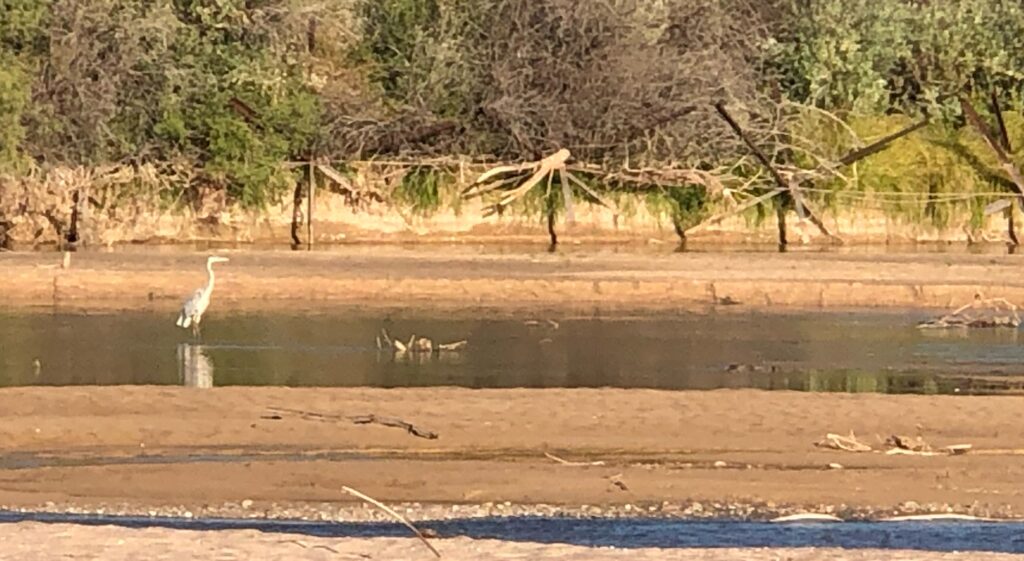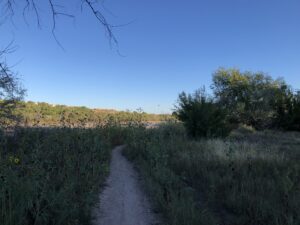Apologies for the pixelated image. I just had the phone, not a camera, and the great blue heron flew before I could get close enough to get a good shot.
I got to the river just as the sun crested the Sandias this morning, and the light was gorgeous.
I’m giving a kinda important talk tomorrow, at a luncheon commemorating the 100th anniversary of New Mexico’s Conservancy Act. It’s a law that changed Albuquerque’s relationship with the Rio Grande, and in a weird sort of way you can see the results of the law in the picture.
The book Bob Berrens and I are writing, Ribbons of Green: The Rio Grande and the Making of a Modern American City (spring 2025, UNM Press), is about how rules change landscapes. The rule in question is the 1923 Conservancy Act, which created the legal framework needed to create what became the Middle Rio Grande Conservancy District. The 1923 statute said this:
[A]ny district so established shall have the power to straighten, widen, deepen, divert or change the course or terminus of any natural or artificial water course.
The Conservancy District is gearing up to commemorate its centennial, and knowing of our book project, the district invited me to give the keynote at the kickoff luncheon tomorrow.
Resting up for the big talk (these things are strenuous!) I took the morning off from working on the book, threw a bike in the car, and headed down to the river before sunup. The neighborhood joggers were out enjoying the cool riverside air as I wandered the maze of singletrack through the woods upstream from the freeway bridge.
Again, the quality of my picture isn’t great. I need to go back with the big camera. But if you look beyond the charismatic fauna to the far bank, you’ll see those big crossed steel contraptions that look like giant jacks (the kids’ toy). They were installed in the 1950s by the U.S. Bureau of Reclamation as part of the river management project that began with the Conservancy Act 30 years before.
In the 1920s, when the New Mexico state legislature approved the first Conservancy Act, Albuquerque was struggling to build a city on a flood plain that had grown increasingly waterlogged. We think of the Conservancy District today as an irrigation agency, but the statute that midwifed its birth barely gives irrigation a mention. It was all about (quoting the original statute here):
- Preventing floods;
- Regulating stream channels by changing, widening and deepening the same;
- Regulating the flow of streams;
- Diverting, controlling, or in whole or in part eliminating water courses;
- Reclaiming, draining, or filling wet and overflowed lands….
Irrigation is there in the first statute if you look hard enough for it, in a section headed “incident to such purposes” – in other words, if along the way to meeting the above goals you feel a need to do some irrigation too, cool, go for it! (Also totally OK: hydropower.)
A series of statutory innovations followed, at both the state and federal level, so it’s a crooked, broken path to the jetty jacks in the 1950s, but if you look hard it’s there. Their purpose was to slow water along the river’s edges so sediment would drop out and build new banklines like you see in the background of the picture above. Up out of the channel, lines of jetty jacks created moist beds of sediment that were ideal for baby cottonwoods. The Rio Grande bosque, a ribbon of cottonwoods more than a hundred miles long, is the result.
The bosque wasn’t intentional. This was all about water management. But you couldn’t have built a better city park if you tried, had meant to.
Resting up for tomorrow’s big talk (these things are strenuous!) I took the morning off from working on the book, threw a bike in the car, and headed down to the river before sunup. The neighborhood joggers were out enjoying the cool riverside air as I wandered up the maze of singletrack through the woods upstream from the freeway bridge.
The river’s low right now, but as I walked out onto sandbars in what the mapping apps color river blue, the birds were enjoying what water there was.


